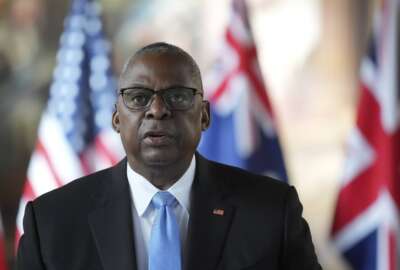Vint Cerf explains DARPA and the Internet
A man readily acknowledged by many as \"the father of the Internet\" says the \"network of networks\" originally bore little in common with the network we know ...
wfedstaff | June 3, 2015 1:38 am
By Max Cacas
Reporter
Federal News Radio
These days, Dr. Vint Cerf has the title “Vice president & Chief Internet Evangelist” with Google here in Washington. But at one time, he was a federal employee, and together with Bob Kahn, and others helped develop the TCP/IP protocols that serve as the basic architecture and building blocks of the Internet.
Doctor Cerf discussed some of that work at the AFCEA Washington scholarship luncheon yesterday.
“Getting an education is absolutely essential to any kind of success,” he told the 17 college seniors who landed scholarships from AFCEA DC to study in a variety of science, math, IT and engineering disciplines when they get to college this fall. Cerf went on to say that education doesn’t stop once you leave college, especially in the fields of science, math and technology.
Cerf citied his own studies in computer science in the 1970s with leading to the ground-breaking work he did in developing the Internet.
He says some of the most fun and interesting jobs he’s had were also the ones carrying the most risk, like the time when the Pentagon’s top scientific research and development agency came calling, asking him to adapt computer data networking technology he helped pioneer to the needs of the warfighter.
While I was at Stanford from 1972-76, I was invited by the Defense Advanced Research Project Agency to come to Washington to run the internet program. And I turned them down. There were actually two incidents, the first time they called in 1975. I flew back here in the middle of a snowstorm. I’d lived for 30 years in California, and this white stuff was kind of unfamiliar.
Eventually, Cerf was persuaded to accept the DARPA position the second time they offered him the same job a year later.
“That was 34 years ago, and we haven’t left Washington since then.”
Cerf says that when he was doing some of his groundbreaking work that led to developing TCP/IP, or the Transport Control Protocol/Internet Protocol, he never envisioned the network evolving into what we see today.
“This packet-switching idea caught the attention of DARPA,” he said, “DARPA was looking for ways to build command-and-control systems that had no central structure, and were highly distributed, and that could be readily reconstituted.”
He also says the original ARPAnet, the technical predecessor to the Internet which at first only linked together university computer centers doing high-level Defense Department research, was born of an economic need.
DARPA was funding research at a dozen research centers at universities around the country. And they all wanted to do world-class research. Of course, they all argued that the only way they could do world-class research was to have world-class computers at each one of those computer science departments. Well, of course, even DARPA couldn’t afford to buy a world-class computer every year for every computer science department, so they said, look, why don’t we build a network so you can share? So, the original ARPAnet project was built to share computing resources among all the computer science departments. It was not built solely to deal with nuclear attack, so it was a resource-sharing system.
And Cerf says that in discussions that foreshadowed today’s development of mobile internet technologies, DARPA then asked him and other researchers to make the original ARPAnet move.
“DARPA said if computers are going to be used in command-and-control, you’re going to have to make them work on aircraft, and mobile vehicles, and ships at sea, and up to that time, the only experience we had was with wireline networks.”
Cerf went on to describe how researchers developed three different networks, a satellite-based network, a mobile-packet radio-based network, and the ARPAnet. He says Bob Kahn, who was already at DARPA, came to his university in 1973, describing the need to make the three separate networks “talk” to one another. Six months later, he says, they published the seminal paper outlining the TCP/IP protocol that enabled DARPA to link together the three different networks — the precursor to the Internet.
Following his speech, Federal News Radio asked Dr. Cerf to reflect on DARPA’s role as an incubator for new technologies that begin as aids to the warfighter, but become something more.
There are some technologies that take a long time to mature. You have to explore dead-ends, you have to allow for failure. And certainly, the program years when I was there allowed for, take ARPAnet and the Internet, 20 years or more of funding. So, if there were any changes to be made in the program, I think it would be in the direction of allowing more longer term programs with higher risk factors. And I think the sitting director, Regina Dugan, is amenable to incorporating into the program more higher risk, longer term, and higher payoff programs, even if they take awhile.
Cerf also notes that other federal agencies have since adopted the DARPA model for branches performing long-term scientific research, pointing to the Department of Energy’s recently opened ARPA-E.
——
For more with Vint Cerf about cloud computing and the federal government on Federal Tech Talk, click here.
(Copyright 2010 by FederalNewsRadio.com. All Rights Reserved.)
Copyright © 2024 Federal News Network. All rights reserved. This website is not intended for users located within the European Economic Area.





